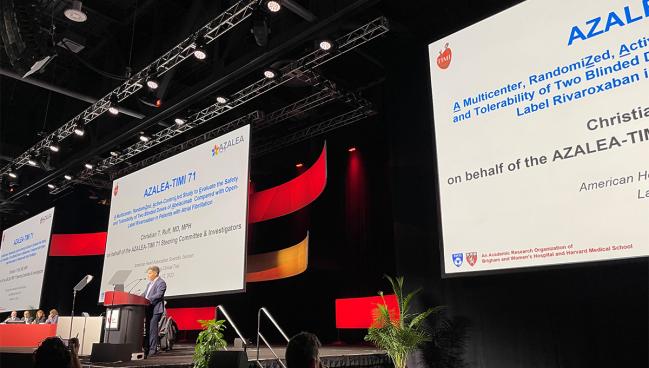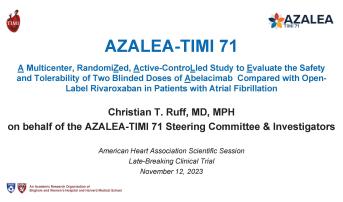NOW PUBLISHED - AZALEA-TIMI 71: Bleeds Plunge With Abelacimab vs Rivaroxaban in AF, but Stroke Impact Unclear
(UPDATED) Stroke was an exploratory endpoint and with few of those events, the PI says it’s impossible to draw any strong conclusions.

TCTMD reported in-depth on the AZALEA-TIMI 71 trial, November 12, 2023, at the American Heart Association (AHA) 2023 meeting. The full manuscript was subsequently published in The New England Journal of Medicine on January 22, 2025. The published results closely match the presentation. Find our full coverage below. |
PHILADELPHIA, PA—The novel factor XI inhibitor abelacimab, given subcutaneously once a month, is far less likely to lead to major and nonmajor clinically relevant bleeding than rivaroxaban in patients at moderate-to-high risk of stroke who have atrial fibrillation (AF), according to the full results of the phase II AZALEA-TIMI 71 trial. However, the impact of the agent on stroke prevention is less clear based on a small number of events in the trial.
AZALEA-TIMI 71 made headlines when it was stopped prematurely in September 2023 by its data monitoring committee due to what was said to be an “overwhelming reduction” in bleeding with both the 150-mg and 90-mg doses.
Compared with those on the direct oral anticoagulant (DOAC) rivaroxaban, patients taking the 150-mg dose of abelacimab (Anthos Therapeutics) saw a 67% reduction in major or clinically relevant nonmajor bleeding, a 74% reduction in major bleeding alone, and a 93% reduction in major GI bleeding, the full results show.
“Gastrointestinal bleeding, which is by far the most common bleeding we see with DOAC therapy, was almost eliminated with both abelacimab doses,” Christian T. Ruff, MD, MPH (Brigham and Women’s Hospital, Boston, MA), said to the media prior to presenting the results here at the American Heart Association (AHA) 2023 Scientific Sessions.
Pivotal trials like ARISTOTLE, ENGAGE AF-TIMI 48, ROCKET-AF & RE-LY cemented the efficacy of the DOACs for stroke prevention in AF, but also showed that they were safer than warfarin and led to less intracranial hemorrhage. However, the ability of DOACs to reduce less serious bleeding has remained unmet and concerns have been raised about their potential to increase GI bleeding, added Ruff, noting that “bleeding or even the fear of bleeding drives substantial undertreatment of our patients.”
How well the new agent does at preventing strokes as compared with rivaroxaban was not addressed when the top-line results were announced.
At AHA, Ruff told TCTMD that there were 25 total strokes in the trial across the three arms, 22 of which were ischemic. The total stroke incidence was 1.0% in the rivaroxaban group and 1.1% in the 150-mg abelacimab group.
“So the ability to compare one arm to another is quite limited. It obviously would take a phase III trial, but I think we are reassured that the rates are substantially lower than what we would have expected in patients who weren't on anticoagulation,” he said. “The conclusion is the rates in general are very low in all three arms suggestive of highly effective anticoagulation.”
AZALEA-TIMI 71
The study enrolled 1,287 patients (median age 74 years; 44% women) from 95 centers in North America, Europe, and Asia and had a median of 21 months of follow-up prior to being stopped. Patients in the rivaroxaban arm received 20 mg of the oral medication daily, while those randomized to abelacimab received either 150 mg or 90 mg subcutaneously on a monthly basis.
The combined rate of major and clinically relevant nonmajor bleeding was 8.1 per 100 patient-years in the rivaroxaban group and 2.7 per 100 patient-years in the 150 mg abelacimab group (HR 0.33; 95% CI 0.19-0.55). In the 90-mg abelacimab group, bleeding occurred at a rate of 1.9 per 100 patient-years (HR 0.23; 95% CI 0.13-0.42) compared with rivaroxaban.
Major bleeding occurred at a rate of 3.7 events per 100 patient-years in the rivaroxaban group versus 1.0 per 100 patient-years in the 150-mg abelacimab group (HR 0.26; 95% CI 0.11-0.61). Similarly, rates of clinically relevant nonmajor bleeding occurred at rates of 4.6 per 100 patient-years and 1.8 per 100 patient-years, respectively (HR 0.39; 95% CI 0.21-0.75). The incidence rates of these events were similarly low and statistically significant in the 90-mg abelacimab group versus rivaroxaban.
GI bleeding occurred at a rate of only 0.1 per 100 patient-years with abelacimab at either dose versus 2.1 per 100 patient-years with rivaroxaban. Intracranial hemorrhage was uncommon and not significantly different between groups.
Rates of ischemic stroke were numerically but not significantly higher with abelacimab, Ruff noted: 1.1 per 100 patient-years in the 150-mg group and 1.3 per 100 patient-years in the 90-mg group versus 0.7 per 100 patient-years in the rivaroxaban group, with P values of 0.42 and 0.28, respectively. No hemorrhagic strokes occurred with the highest abelacimab dose, while there were rates of 0.3 per 100 person-years with rivaroxaban and 0.1 per 100 person-years with the 90 mg group.
For the net clinical outcome, a composite of ischemic stroke, systemic embolism, major or clinically relevant nonmajor bleed, and all-cause death, there was a statistically significant difference in both abelacimab groups compared with rivaroxaban (P < 0.001 for both comparisons).
Abelacimab was well- tolerated overall, and injection-site reactions were uncommon.
To TCTMD, Ruff said he is confident that the data support the 150-mg dose of abelacimab, which is what will be tested in the phase III LILAC-TIMI 76 trial looking at patients at high risk of stroke who have been deemed unsuitable for oral anticoagulation. It is also the dose that rivaroxaban patients from AZALEA-TIMI 71 transitioned to as part of an extension arm when the trial was halted in September. Those patients will act as a kind of registry cohort for gathering long-term data on abelacimab.
“The real promise of factor XI is there doesn’t appear to be a trade-off, . . . and that’s why it makes sense to pick the most potent dose to study in the phase III,” he added.
Speaking in the same press conference, Martin Leon, MD (NewYork-Presbyterian/Columbia University Irving Medical Center, New York, NY), said he was struck by the magnitude of the reduction in GI bleeding, adding “I hadn’t expected that.”
Discussant Manesh Patel, MD (Duke Clinical Research Institute, Durham, NC), noted that 40% of AF patients at risk for stroke don’t receive an anticoagulant and in those who do, the annual rate of major bleeding is 2% to 3% with a DOAC.
He called the bleeding reductions in AZALEA-TIMI 71 “pretty striking,” noting that both doses of abelacimab showed greater than 95% inhibition of factor XI from baseline to 3 months, supporting the hypothesis that the drug is biologically effective.
Another novel agent, asundexian (Bayer). also has shown better than 90% inhibition of factor XI, with about 66% less bleeding compared with apixaban in patients with AF, as demonstrated in the PACIFIC-AF trial, Patel added.
He noted that the next several years will see much in the way of phase III trials of these new class of drugs. In addition to LILA-TIMI 76, there are ongoing investigations of asundexian in OCEANIC-AF and OCEANIC STROKE, as well as the LIBREXIA series of trials testing milvexian (Bristol-Myers Squibb) in AF, secondary stroke prevention, and ACS.
Speaking with TCTMD, session co-moderator Roopinder Sandhu, MD (Cedars-Sinai Medical Center, Los Angeles, CA), said the primary reason that AF patients are not on oral anticoagulation is the same number-one reason why physicians don't prescribe anticoagulation: fear of bleeding.
“So, I do think that there is going to be a significant role for these agents moving forward,” she said.
“They could be the future, but we don't know,” Jonathan Piccini, MD (Duke University Medical Center, Durham, NC), the other co-moderator, told TCTMD. “The most important reason we prescribe these medications is to prevent stroke. So, until we have pivotal large clinical trials that can demonstrate that these drugs are effective, their future will be uncertain. However, I think it's pretty incredible to think about all the different classes of medications and devices we're going to have to prevent stroke in the next 5 to 10 years. The complexity is going to expand dramatically, and the great thing is that patients will have lots of choices.”
Piccini observed that the current era of medicine is seeing a dramatic rise in the use of subcutaneously delivered agents.
“I'm sure some patients will have a preference to avoid that,” he said, “and I'm sure some patients are going to love the fact that they'll have much better adherence, and they're only going to need to worry about it once a month or once every 6 months, depending upon which drug we're talking about. “
One catch is that, so far, there are no reversal agents for factor XI inhibitors, Sandhu noted. “However, when patients do have a bleeding event, we know from the previous NOAC trials that supportive care is usually enough to help with the treatment,” she added.
As demonstrated in the pivotal DOAC trials, Piccini said, “the need for [reversal agents] was vanishingly small.”
L.A. McKeown is a Senior Medical Journalist for TCTMD, the Section Editor of CV Team Forum, and Senior Medical…
Read Full BioSources
Ruff CT. Abelacimab, a novel factor XI/XIa inhibitor, vs rivaroxaban in patients with atrial fibrillation: primary results of the AZALEA-TIMI 71 randomized trial. Presented at: AHA 2023. November 12, 2023. Philadelphia, PA.
Disclosures
- Ruff reports grants to his institution from Anthos, AstraZeneca, Daiichi Sankyo, Janssen, and Novartis; and honoraria for scientific advisory boards and consulting from Altimmune, Anthos, Bayer, Bristol Myers Squibb, Daiichi Sankyo, Janssen, Merck, and Pfizer.






Comments